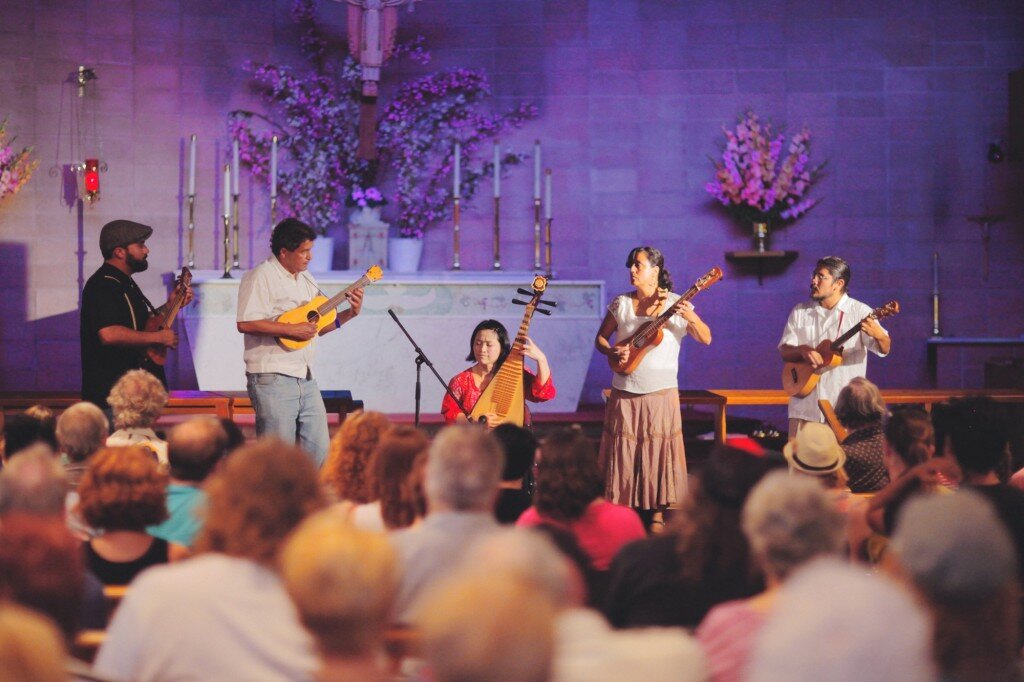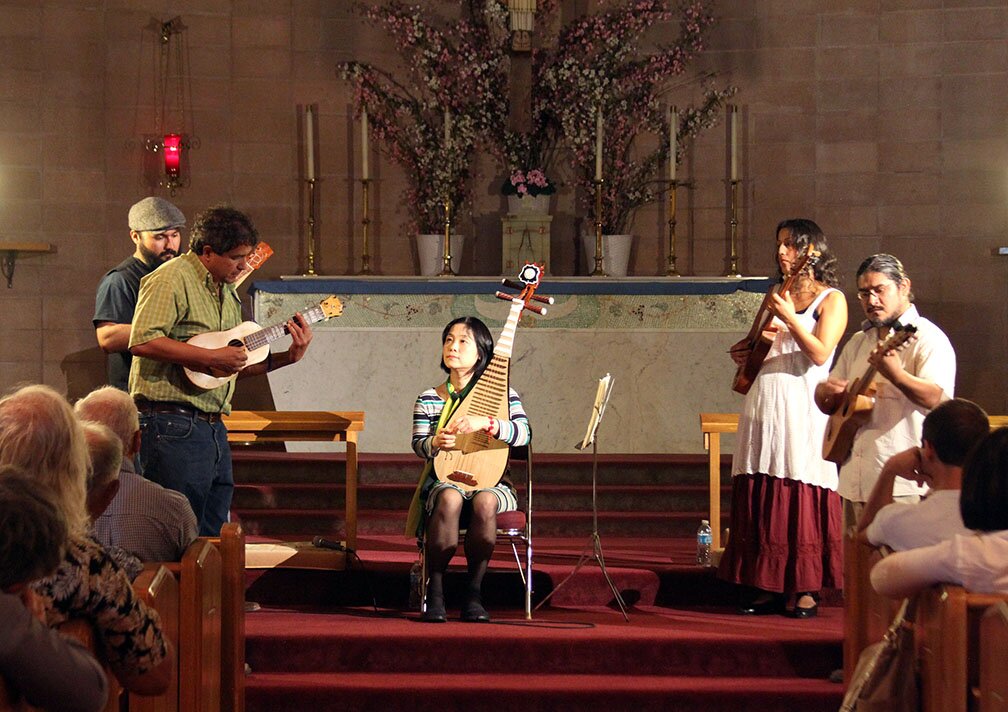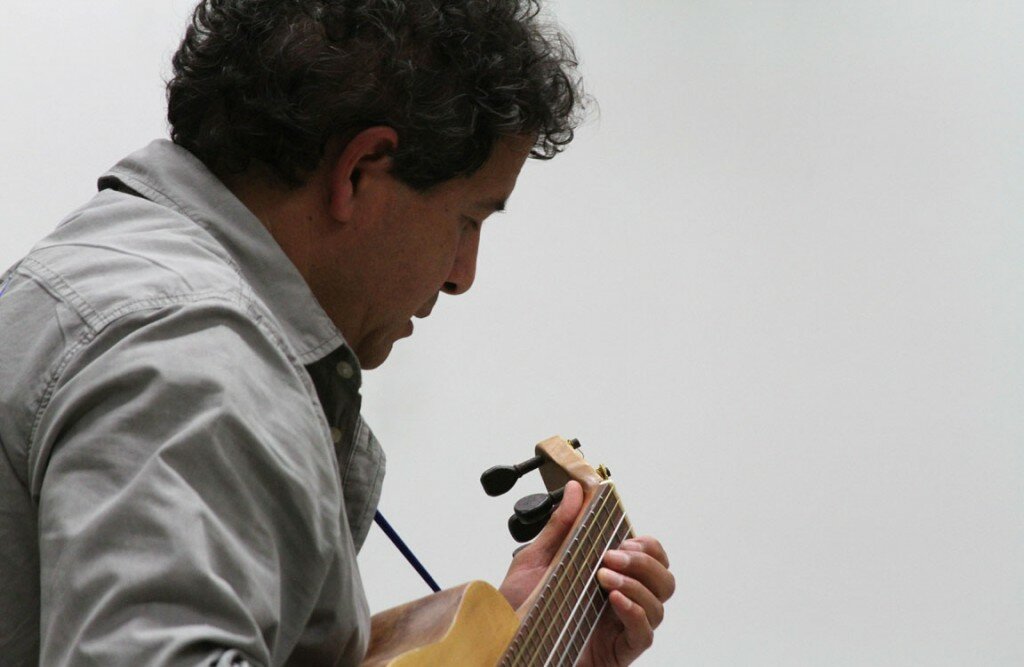Refelctings: When China meets Latin America
Collaborating with Wu Man in bringing together Mexican instruments with her pipa has been a very fun experience. The color and texture is great! We started with lots of curiosity about the sounds, tunings, scales and range. It was very pleasing to see that our curiosity was matched by that of the audience. As we walk to the sanctuary of St Michael’s by the Sea on May 21st for our most recent performance, curiosity was still a big part of it.
- Eduardo Garcia Acosta
‘El Pajaro Carpintero’ performed by Wu Man x Son de San Diego
Recorded on May 13 during the Wu Man x Son de San Diego public workshop at St. Michael’s by the Sea in the Carlsbad Village.
Wu Man and Son de San Diego will be performing again in the Carlsbad Village during the June 21 Music Walk.
Click HERE to learn more about the Music Walk.
My reflections on the St. Michael’s by the Sea Workshop
I want to sharing with you an amazing event with my colleagues from Son de San Diego two days ago. We together presented “When China meets Latino America ” at St. Micheal’s by the Sea, May 12, in Carlsbad! We gave a one hour colorful and passionate program and Q & A session, which got enthusiastic response from mixed audience! So glad to see mixed faces from audience including Chinese, Mexican, kids, all different ages!
I am so happy to see that our first public presentation got great feedback! I am looking forward to our concert in June 21 at The Village Walk!
- Wu Man
Wu Man on Valley Public Radio
World-renowned pipa artist Wu Man talks with Valley Public Radio’s Joe Moore prior to her performance with the Fresno Philharmonic in April 2014.
Wu Man concerto written for her by Zhao Jiping : REVIEW
The Buffalo Philharmonic Orchestra is paying the pipa this weekend, and however much they are paying her, she is worth every penny.
Wu Man emerged from the wings Saturday night in a red and gold dress and raspberry-colored tights and stole the hearts of the listeners (a bigger crowd than you would think, considering the snowstorm that hit at the last minute). Her charm was topped only by her virtuosity on the pipa, a large traditional Chinese lute-like instrument.
The pipa sounds like a cross between the banjo and the balalaika. Concentrating beneath her black bangs, Wu Man flew up and down its strings with supreme agility. Each note was sharp and distinct, and there was such a variety of articulations – a chirp, a rattle, a sharp snap – that you had to smile. The instrument’s unfamiliarity was part of the fun. Sometimes the notes bend up at the end, lending a bittersweet tone.
Wu Man is playing a concerto written for her by Zhao Jiping, a composer trained in Beijing and known for his movie scores, most notably “Farewell, My Concubine” and “Raise the Red Lantern.”
Jiping’s concerto, and I say this with deep admiration, harks back to old Hollywood. It feels as if it could accompany an epic. His melodies linger in your mind. His musical language occasionally made me think of the Hollywood Bowl’s great Carmen Dragon, whose sparkling Christmas carol arrangements we often hear at Holiday Pops. Jiping sometimes has the violins playing portamento. There are muted, poetic woodwinds.
Against this lush backdrop, Wu Man could always be heard, the notes crisp as crystals. She always gave the impression of being engaged with the orchestra, Associate Conductor Matthew Kraemer and the audience. The end was lovely, with valedictory chirps from the orchestra musicians, in various combinations, accompanying the pipa’s closing melodies. Jiping seemed to be borrowing from Richard Strauss, who did something similar in his Four Last Songs.
The audience loved it, and many stood and cheered, and the applause went on for so long that Wu Man played an encore. I don’t want to give away just yet what it was called. The title was so funny and so apt, and she might play it again today, if today’s crowd is lucky.
The entire concert has a theme of sensuality. It has memorable ambiance. Kleinhans is strung with red Chinese lanterns in honor of the music’s Asian flair. Artists are in the lobby demonstrating calligraphy and other Chinese paper arts.
First on the program is Charles Tomlinson Griffes’ “The Pleasure Dome of Kubla Khan,” a piece that sparkles with the twinkle of the celeste, the thrilling whoosh of gongs. You hear a languorous melody from the oboe, a rich and beautiful cello theme. It builds to a great crest, with gongs and timpani going full power and the great volume finally dissolving into a soft muttering. This piece and the BPO have a storied history. The orchestra recorded it on Naxos, and it was performed as far back as 1941, with Franco Autori conducting.
In contrast, Borodin’s “In the Steppes of Central Asia” reportedly had never been performed here before, at least not on the Classics series. This enchanting piece, a sound picture of a Tsarist Russian military caravan passing an Arab caravan in the middle of nowhere, is a tremendous pleasure to hear live. Kraemer paced it well, and the musicians handled all the essential tiny details beautifully. In a way, this piece was the heart of the concert, with its portrait of two very different cultures greeting each other with friendliness and a kind of unspoken acknowledgment of kinship. Christine Bailey did a lovely job with the faint final phrase, as the Tsar’s soldiers vanish into the distance.
The concert closed with Debussy’s Three Nocturnes, the most sensuous music imaginable. The women of the Buffalo Philharmonic Chorus, after waiting all evening for their turn in the spotlight, sang out in that third Nocturne as if they enjoyed it. Kraemer kept the tempo going and didn’t let things get too cloudy.
source : http://www.buffalonews.com/gusto/concert-reviews/asian-themed-concert-delivers-an-exotic-flair-20140329
The Magic Sound of Strings by Eduardo Garcia Acosta
“Close your eyes, listen, and let your imagination wander… That is about the only thing I would say about this project. It sounds easy enough. But it is a little more complicated than that.
How will it work? Well, first we have to do a lot of listening to one another. The next thing we tend to do instinctively is to imitate each other’s sounds and as we find our way we come to images of what the music is doing and how that compares with what our instruments can do for us. And then of course as the listening becomes deeper one realizes the sounds, all along, are and have been like a party falling down on us from the astonishment of birds.
The idea of bringing together Chinese and Mexican strings seemed, in the beginning, unimaginable; two distant cultures with two distinct musical traditions. But as we started sounding our instruments we realized there is a familiarity and difference at the same time. The magic sound of strings is such that it has enchanted our hearts and ears. We have found common ground in love songs, silvery dawns, birdsongs, broken hearts, tales of sailing, and the cheer joy of dancing. Pentatonic scales are used in different cultures around the world and that is true of China and Latin America… another commonality found.
This has proved to me once more the universality without borders that music is, for as many esthetic differences between the two musical cultures, it affords us once more the opportunity to love that, which moves us to coincide.
I am being reminded of the fact that now as in the past music has migrated –it is related to people migrating- from one place to another. Taking music to wherever one goes promotes respect.
China, América Latina
con sus cuerdas van unidas;
y vibraciones sentidas
son mancuerna que fascina.
La distancia se elimina
compartiendo los sonidos
dados bien, bien recibidos
de la Pipa a la jarana
y al requinto que se hermanan:
en sonoro verso, unidos
China and Latin America
are united through their strings
their heartfelt vibrations
are a fascinating team.
Distance lost its meaning
as these sounds are to be shared
good will giving and recceiving
the pipa, jarana, fandango,
and requinto sing together
and in song they all convene.
- Eduardo
4th rehearsal with Son de San
I had my 4th rehearsal with Son de San Diego today! I brought two Chinese melody to share in our rehearsal. Eduardo played on pan-flute of my piece Dancing and it turned out so beautiful! I am so happy to see the results. The color of the instrumentation was amazing. I have a good feeling about our collaboration.
Hope we can share with public soon!
-Wu Man
Wu Man’s creates cinematic grandeur
Watch Wu Man play ancient music from her Chinese homeland in the NPR Music offices. When her fingers start to fly, Wu Man can create scenes of cinematic grandeur or serene, moonlit moments.


